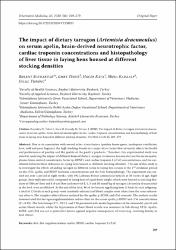The impact of dietary tarragon (Artemisia dracunculus) on serum apelin, brain-derived neurotrophic factor, cardiac troponin concentrations and histopathology of liver tissue in laying hens housed at different stocking densities

View/
Access
Attribution-NonCommercial-NoDerivs 3.0 United Statesinfo:eu-repo/semantics/openAccesshttp://creativecommons.org/licenses/by-nc-nd/3.0/us/Date
2020Access
Attribution-NonCommercial-NoDerivs 3.0 United Statesinfo:eu-repo/semantics/openAccesshttp://creativecommons.org/licenses/by-nc-nd/3.0/us/Metadata
Show full item recordAbstract
Due to its association with several other stress factors (poultry house gases, inadequate ventilation, heat, cold and poor hygiene), the high stocking density is a major stress factor that adversely affects the health and performance of poultry and the quality of the poultry products. Therefore, this experimental study was aimed at analysing the impact of different doses of dietary tarragon (Artemisia dracunculus) on the serum apelin, plasma brain-derived neurotrophic factor (p-BDNF), and cardiac troponin I (cTnI) concentrations, and the correlation between these indicators in laying hens housed at different stocking densities. The aim of this study is to investigate the effects of adding tarragon in different ratios to laying hen rations in the 2nd ovulation period on the cTnI, apelin, and BDNF hormone concentrations and the liver histopathology. The experiment was carried out over a period of eight weeks, with 192 Lohman Brown commercial hybrids at 50 weeks of age. Eight groups (four replicates each), composed of laying hens of equal body weight, which were housed at stocking densities of 580 cm(2)/hen and 810 cm(2)/hen and received 0, 1, 5 and 10 mmol/kg of tarragon (Artemisia dracunculus) in the feed, were established. At the end of the trial, 96 of the housed egg-laying hens (3 birds in each subgroup, a total of 12 birds in each group) were randomly selected and blood samples were taken from the vena subcutanea ulnaris. The samples collected were analysed for the apelin, p-BDNF, and cTnI contents. The analysis results demonstrated that tarragon supplementation had no effect on the serum apelin, p-BDNF and cTnI concentrations (P > 0.05). The Sub-Groups ST1, ST1.2, and ST6 presented with severe hyperaemia of the sinusoidal, portal and acinar blood vessels, whilst the hyperaemia of these blood vessels was moderate in Sub-Group ST12. Apelin, BDNF, and cTnI can act as protective factors against negative consequences of stress (e.g., stocking density or heat stress).
Volume
65Issue
6Collections
The following license files are associated with this item:


















